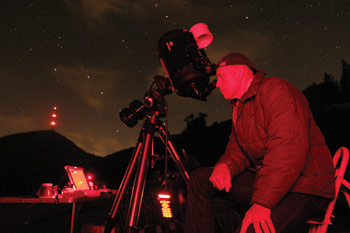To the naked eye, the night sky is a drizzle of starlight beacons that pierce the tarry black. But the moon is there too, often shining so brightly it overpowers its celestial brethren. That's why serious astronomers schedule their viewings during the new moon phase — and as far away from city lights as possible.

Just after dark recently, I arrived at the Mount Pisgah parking lot — the appointed meeting place for the Astronomy Club of Asheville — and noticed a few stooped shadows stationed around their vehicles. I also caught a few stray, unexplained red rays as I drove up, and when my headlights illuminated the scene, I saw heads pop up like angry gophers. Quickly killing my halogens, I drove the rest of the way in by the light of my fog lamps.
It takes at least 20 minutes for the eyes to fully adjust to the dark, the assembled astronomers told me. This explained the red-lens-capped flashlights everyone sported. The caps filter the white light just enough so that everyone can safely move around the telescopes without being blinded.
"Look into there," Monte Snell suggested as I tried to blend in. Leaning toward his voice, I pressed my eye against the scope's view piece. "It's Jupiter: You see it?" asked Snell.
"You mean the white spot," I said.
"That — and there's one dot to the right of it and three on the left. Those are the moons," Snell replied.
A nearby voice added, "Those moons are constantly shifting. The one over there by itself is Callisto, and then you've got Ganymede, Io and Europa on the other side." The speaker was Jim Brown, who continued, "That sharp black spot in the center should be the red spot."
I never really thought about it until I looked through the telescope, but it was actually a thrill to get to know a few of Jupiter's 63 confirmed moons and notorious red spot.
Established in 1981, the club now has around 40 members. And the more I talked with club members about why they comb the night with their prying, augmented eyes, the more I understood that it's the quest for knowledge that drives them to observe until their eyes are sore and tired. For some, that means staying out nearly all night, but for a passionate astronomer, exploring and understanding the alien matter surrounding our world is as much of a rush as a 20-foot jump is to a mountain biker.
Astronomers aren't the only ones who attend these new-moon gatherings, though. Jeremy Lerner is a self-described instrument builder who constructed his own telescope from scratch. Ironically, he's more interested in building the tools than in using them. "I have literally been out to look at stars [just] 12 times in the last 20 years," he said. For Lerner, the thrill in astronomy is "building something that no one else has." He didn't have his creation with him that night, but he promised he'd try to remember to bring it next time.
As I walked back and forth between the twin telescopic stations, I stopped at Brown's Mead LX200R. Its computer-controlled, swiveling head whined as it followed digital orders dialed in by its owner. This sophisticated piece of equipment can interface with public-access space information on the Internet and then later track such events as space-station activity. New, a machine like this costs well over $3,000.
But you don't have to spend a lot of money to have fun out here. With just a pair of binoculars, it's a revelation to see that the Pleiades, a constellation also known as the Seven Sisters, actually contains many more than seven stars. This cosmic wonder, once venerated by the ancients of many nations, is a prime target for winter sightings.
Warm weather humidity and the pollution that adheres to it muddy the otherwise clear night, so a cold winter night is the best time for viewing. Accordingly, club members plan to bundle up and take advantage of the clear vantage point no matter how cold it gets. Meetings are scheduled throughout the winter months, and visitors are welcome — with or without telescope. For details on upcoming meetings, visit www.astroasheville.org.
Just be sure to douse your lights before you hit the parking lot.
On the evenings of Sunday, Dec. 13, and Monday, Dec. 14, keep an eye out for possibly the best meteor shower of 2009 — the Geminid. Visit www.astronomy.com for viewing tips and more information.
Freelancer Jonathan Poston lives near Asheville.
It's the quest for knowledge that drives club members to observe until their eyes are sore and tired.



Before you comment
The comments section is here to provide a platform for civil dialogue on the issues we face together as a local community. Xpress is committed to offering this platform for all voices, but when the tone of the discussion gets nasty or strays off topic, we believe many people choose not to participate. Xpress editors are determined to moderate comments to ensure a constructive interchange is maintained. All comments judged not to be in keeping with the spirit of civil discourse will be removed and repeat violators will be banned. See here for our terms of service. Thank you for being part of this effort to promote respectful discussion.